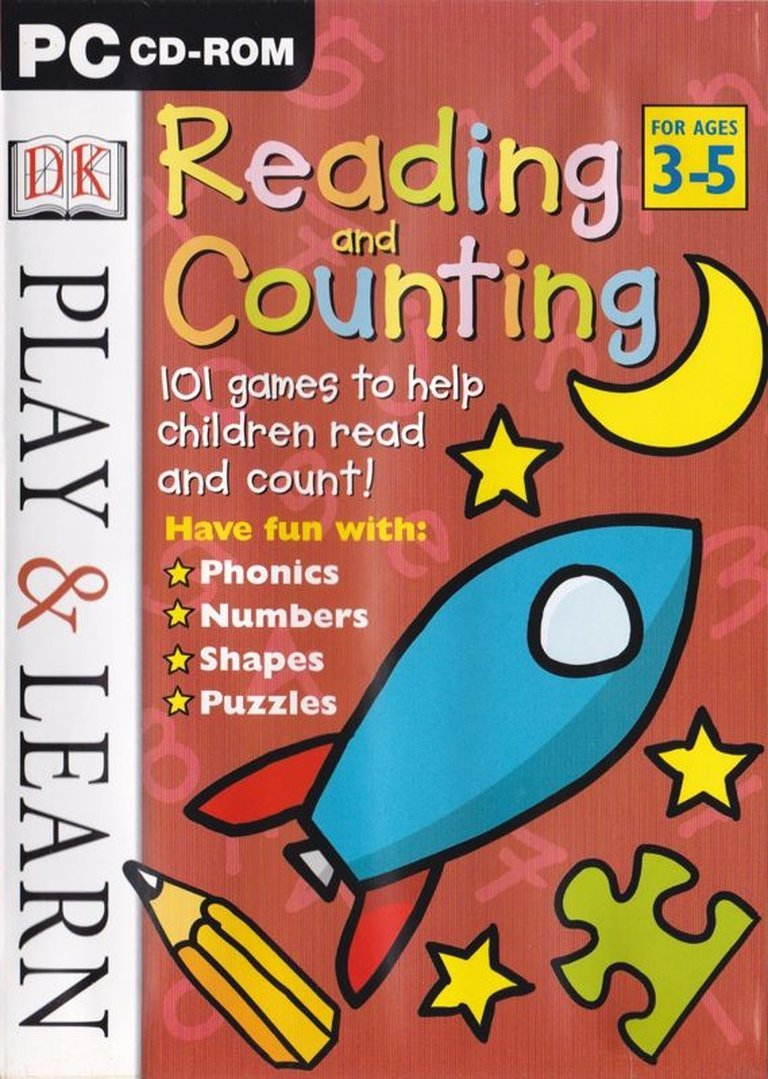- Release Year: 2001
- Platforms: Windows
- Publisher: DK Multimedia, Global Software Publishing Ltd.
- Developer: Studio Lascaux (Belgium)
- Genre: Educational
- Perspective: Third-person
- Game Mode: Single-player
- Gameplay: logic, Math, Mini-games, Puzzle elements, Reading, writing
- Setting: Pre-school, toddler
- Average Score: 100/100

Description
Play & Learn: Reading and Counting is an educational game designed for young children aged three to five years old, featuring 101 mini-games that teach phonics, numbers, shapes, and logic through interactive gameplay.
Gameplay Videos
Reviews & Reception
myabandonware.com (100/100): In 2000, DK Multimedia, Global Software Publishing Ltd., Dorling Kindersley publishes Play & Learn: Reading and Counting on Windows.
Play & Learn: Reading and Counting: Review
Introduction
Play & Learn: Reading and Counting is a seminal educational title released in 2001 for young children aged between three and five years old. Developed by Studio Lascaux and published by DK Multimedia, this game has been a cornerstone in early childhood education, focusing on phonics, numbers, shapes, and logic through engaging mini-games. This review will dissect the game’s development history, narrative, gameplay mechanics, world-building, and reception to provide a comprehensive analysis of its impact and legacy.
Development History & Context
Studio Lascaux, a Belgian development studio, crafted Play & Learn: Reading and Counting with a clear vision to create an engaging educational experience. The game’s release in 2001 positioned it within a burgeoning market of edutainment titles. The technological constraints of the era, such as reliance on CD-ROMs and mouse controls, influenced the game’s design. The gaming landscape at the time was shifting towards more diverse genres, and educational games like Play & Learn: Reading and Counting filled a niche for young learners.
Narrative & Thematic Deep Dive
While Play & Learn: Reading and Counting is not centered around a traditional narrative, its educational content is presented through various thematic categories, including shapes, sounds, pairs, mix & match, numbers, letters, mazes, puzzles, and more games. Each category is designed to teach specific skills, from basic phonics and numeracy to problem-solving and logic. The game’s thematic depth lies in its ability to adapt to different learning styles, offering visual, auditory, and kinesthetic learning experiences.
Gameplay Mechanics & Systems
The gameplay is divided into 101 mini-games across several categories:
* Shapes and More Shapes: Teach recognition and construction of shapes.
* Sounds and Pairs: Enhance auditory recognition and memory.
* Mix & Match: Develop problem-solving skills.
* Numbers and Letters: Introduce basic numeracy and literacy.
* Mazes and Puzzles: Improve logic and spatial awareness.
The game is entirely mouse-controlled, running in full-screen mode directly from the CD. This design choice ensured a seamless and immersive experience for young players.
World-Building, Art & Sound
The game’s world is constructed around vibrant, colorful graphics and engaging animations. The use of relatable objects and characters enhances the learning experience, making it both enjoyable and memorable. The sound design, including sound effects and voiceovers, complements the visual elements, providing an engaging multisensory experience.
Reception & Legacy
Upon release, Play & Learn: Reading and Counting received positive reviews for its engaging educational content and user-friendly interface. Although specific critic reviews are not available, the game’s impact is evident in its continued presence in educational gaming discussions. It has influenced subsequent educational titles and remains a beloved choice among parents and educators for its balanced approach to learning.
Conclusion
Play & Learn: Reading and Counting stands as a testament to the potential of educational gaming to engage young minds effectively. Its thoughtful design, adaptability to different learning styles, and engaging gameplay mechanics have cemented its place in the history of video games. As an educational title, it not only taught foundational skills but also fostered a love for learning in countless children. Its legacy continues to be felt, making it a significant title in the edutainment genre.